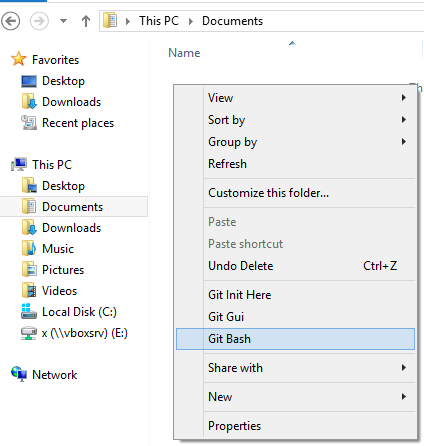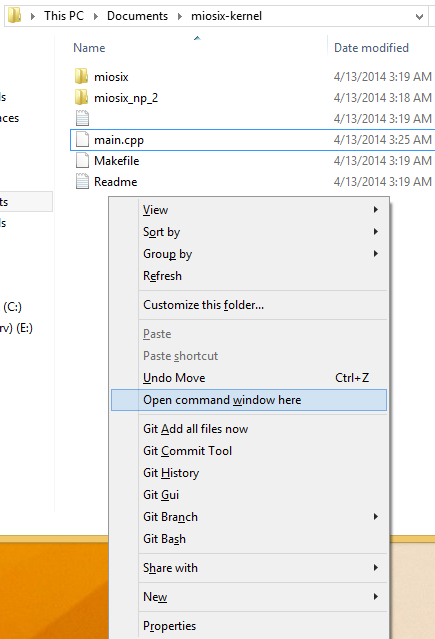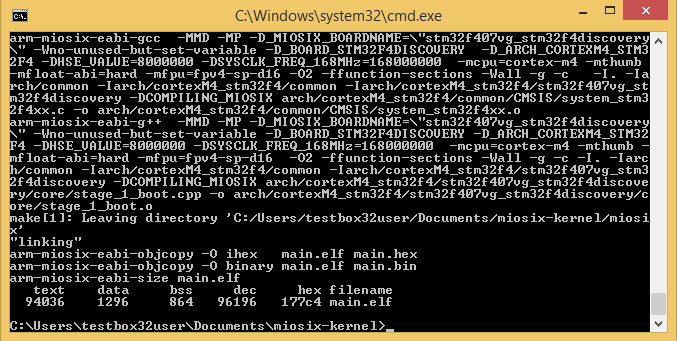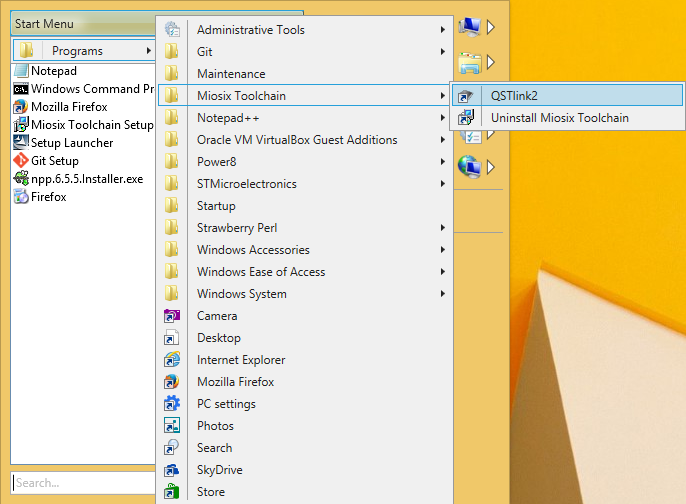Windows Quick Start: Difference between revisions
No edit summary |
No edit summary |
||
| Line 17: | Line 17: | ||
=== Get the Miosix kernel sources === | === Get the Miosix kernel sources === | ||
Go to the directory where you want to dowload the Miosix kernel, for example the Documents directory, and right-click on it. Select ''Git bash'' to open a git shell. There you can type the commands to download the kernel. Currently, Miosix 2.0 is in the ''testing'' branch of the git repository, while the default one, the ''master'' branch, contains Miosix 1.x. So, you need to explicitly switch to the testing branch after downloading the kernel. | Go to the directory where you want to dowload the Miosix kernel, for example the Documents directory, and right-click on it. Select ''Git bash'' to open a git shell. There you can type the commands to download the kernel. | ||
[[File:Gitbashwindows.png]] | |||
Currently, Miosix 2.0 is in the ''testing'' branch of the git repository, while the default one, the ''master'' branch, contains Miosix 1.x. So, you need to explicitly switch to the testing branch after downloading the kernel. | |||
<source lang="bash"> | <source lang="bash"> | ||
| Line 37: | Line 41: | ||
'''Top-level directory''' | '''Top-level directory''' | ||
First of all the miosix-kernel directory is often referred to as the '''top-level directory''' of the kernel. It contains, among other, the ''main.cpp'' file which is where you can start writing your application code, the ''Makefile'' where you can add additional C++ and C source files to be compiled, and the ''miosix'' directory which contains the kernel. All paths in this wiki, unless they start with a '/' (for Linux) or 'C:\' (For Windows), are intended relative to Miosix's top-level directory, so if we're talking about the 'miosix/config/Makefile.inc' file you can find it within the directory where you have downloaded the kernel from git. | First of all the miosix-kernel directory is often referred to as the '''top-level directory''' of the kernel. It contains, among other, the ''main.cpp'' file which is where you can start writing your application code, the ''Makefile'' where you can add additional C++ and C source files to be compiled, and the ''miosix'' directory which contains the kernel. | ||
[[File:Miosixtopleveldirectorywindows.png]] | |||
All paths in this wiki, unless they start with a '/' (for Linux) or 'C:\' (For Windows), are intended relative to Miosix's top-level directory, so if we're talking about the 'miosix/config/Makefile.inc' file you can find it within the directory where you have downloaded the kernel from git. | |||
'''Configuring the kernel''' | '''Configuring the kernel''' | ||
| Line 68: | Line 76: | ||
//#define JTAG_DISABLE_SLEEP | //#define JTAG_DISABLE_SLEEP | ||
</source> | </source> | ||
(which is towards the end of the file). This is a C++ header file, so the comment syntax is '//'. More information on the meaning of this line can be found in [[ | (which is towards the end of the file). This is a C++ header file, so the comment syntax is '//'. More information on the meaning of this line can be found in [[miosix_settings.h]], but a short summary is that this line prevents the kernel from putting shutting down the CPU when it has nothing to do, which saves power but interferes with the programming/debugging protocol used to program the board via QSTLink2. | ||
'''Blink a LED''' | '''Blink a LED''' | ||
| Line 91: | Line 99: | ||
'''Compiling''' | '''Compiling''' | ||
To compile the kernel, open a DOS shell in the Miosix top-level directory (you can | To compile the kernel, open a DOS shell in the Miosix top-level directory (you can 'Shift+Right click' in the top-level directory and choose 'Open command window here' in modern versions of Windows), otherwise you will have to ''cd'' your way into that directory. | ||
[[File:Openterminalwindows.png]] | |||
Otherwise, compiler errors will appear in the DOS prompt. | To compile the kernel type ''make'' in the DOS prompt. If all goes well, the result should look like this. | ||
[[File:Makeoutputwindows.png]] | |||
Otherwise, compiler errors will appear in the DOS prompt. The number that appears under ''text'' in the make output is the size in bytes of your application plus the kernel. If you think that 90KBytes is a bit too much for a blinking led, don't worry. The kernel by default includes support for C stdio functions, filesystem code including Unicode support and the C++ exception handling runtime, all of which can be disabled to significantly [[Miosix code size optimization|reduce code size]]. | |||
'''Programming''' | '''Programming''' | ||
There are two ways to program the stm32f4discovery board. One is to | There are two ways to program the stm32f4discovery board. One is to use QSTLink2 from the DOS prompt by typing 'make program' in the (connect the USB cable first!), the other is through QSTLink2's GUI. You can find QSTLink2 in the start menu | ||
[[File:Qstlink2startmenuwindows.png]] | |||
Once you start it, you have to click on ''Connect'', and it should find your ''stm32f4discovery'' board. After that, click on ''Send'' and select the ''main.bin'' file in the Miosix top-level directory. | |||
[[File:Qstlink2flashingwindows.png]] | |||
Note that, regardless of using QSTLink2 form the DOS prompt or the GUI, there is a bug that in some circumstances blocks the microcontroller until the next powercycle. Therefore, after having programmed the microcontroller, is is recomended to unplug and reconnect the USB cable to powercycle the ''stm32f4discovery'' board. At that point, you shuold see the red LED blinking. | |||
Revision as of 10:58, 13 April 2014
Before you begin
Before you can install the Miosix Toolchain on Windows, you will need to install [git], which is necessary to download the Miosix kernel and keep it up to date, [Perl], which is a scripting language used when compiling the kernel, and the STLink drivers if you want to program stm32 boards that have an USB-based STLinkV2 programmer/debugger.
- For git, it is recomended to install it from [git-scm.com]. Please do not uncheck the Windows Explorer integration feature during the installation, as you will need it to install the kernel sources.
- [Strawberry perl] is the recomended perl version for Miosix on Windows
- The STLink drivers can be found on the [ST website].
Finally, it is recomended to download a better text editor than Notepad or WordPad, as you will need it to edit the Miosix configuration files. [Notepad++] is a good option, but many other options exist. Just don't use notepad, because it does not recognize Unix [line-endings] and will show you Miosix source files as if they were composed of a single line of text.
Once you have downloaded and installed the aforementioned software, you can proceed with the installation of the Miosix Toolchain.
Install the Miosix Toolchain
Download the [Miosix Toolchain installer] and run it. At the end you will need to reboot your computer (sorry, it's Windows...)
Get the Miosix kernel sources
Go to the directory where you want to dowload the Miosix kernel, for example the Documents directory, and right-click on it. Select Git bash to open a git shell. There you can type the commands to download the kernel.
Currently, Miosix 2.0 is in the testing branch of the git repository, while the default one, the master branch, contains Miosix 1.x. So, you need to explicitly switch to the testing branch after downloading the kernel.
git clone https://git.gitorious.org/miosix-kernel/miosix-kernel.git
cd miosix-kernel
git fetch origin
git checkout -b testing origin/testing
exit
Note that it is possible to paste commands in the shell (so as to avoid typing them, which can be tedious and lead to typos), but you have to do it one line of text at a time, and to paste you need to use the Shift+Ins shortcut, not the usual Ctrl+v one. The last command, exit, will close the shell.
Note that there is also a 'Git GUI' in the right click menu, but since I don't know how to use it, you're on your own if you choose that route.
Configuring and compiling the kernel
More in-depth information on how th configure the kernel for your board can be found in the Board List, but for now we will assume you have an stm32f4discovery, which is a common board, and briefly show how to get to a blinking LED example.
Top-level directory
First of all the miosix-kernel directory is often referred to as the top-level directory of the kernel. It contains, among other, the main.cpp file which is where you can start writing your application code, the Makefile where you can add additional C++ and C source files to be compiled, and the miosix directory which contains the kernel.
All paths in this wiki, unless they start with a '/' (for Linux) or 'C:\' (For Windows), are intended relative to Miosix's top-level directory, so if we're talking about the 'miosix/config/Makefile.inc' file you can find it within the directory where you have downloaded the kernel from git.
Configuring the kernel
The kernel is configured by editing two files, named miosix/config/Makefile.inc and miosix/config/miosix_settings.h. Open the first one in Notepad++, and select your board. To do so, look for the OPT_BOARD section of the file, which looks like this:
##
## Target board, choose one. This also implicitly select the target
## architecture
##
#OPT_BOARD := lpc2138_miosix_board
OPT_BOARD := stm32f103ze_stm3210e-eval
#OPT_BOARD := stm32f103ve_mp3v2
#OPT_BOARD := stm32f100rb_stm32vldiscovery
#OPT_BOARD := stm32f103ve_strive_mini
#OPT_BOARD := stm32f103ze_redbull_v2
#OPT_BOARD := stm32f407vg_stm32f4discovery
#OPT_BOARD := stm32f207ig_stm3220g-eval
#OPT_BOARD := stm32f207zg_ethboard_v2
#OPT_BOARD := stm32f207ze_als_camboard
#OPT_BOARD := stm32l151_als_mainboard
#OPT_BOARD := stm32f407vg_bitsboard
#OPT_BOARD := stm32f205rg_sony-newman
In Makefile syntax a '#' sign denotes a comment, so to select a board you have to comment out (by prepending a '#') the default board selected, and uncomment (by removing the '#' at the start of the line) your board, in this case, which in this example will assume is the stm32f407vg_stm32f4discovery.
Next, edit the miosix_settings.h using Notepad++ and uncomment (by removing the '//' at the start of the line) the following line
//#define JTAG_DISABLE_SLEEP
(which is towards the end of the file). This is a C++ header file, so the comment syntax is '//'. More information on the meaning of this line can be found in miosix_settings.h, but a short summary is that this line prevents the kernel from putting shutting down the CPU when it has nothing to do, which saves power but interferes with the programming/debugging protocol used to program the board via QSTLink2.
Blink a LED
Open the main.cpp file in the top-level directory using Notepad++, and replace its content with the following program:
#include <miosix.h>
using namespace miosix;
int main()
{
for(;;)
{
ledOn();
Thread::sleep(1000);
ledOff();
Thread::sleep(1000);
}
}
The Miosix board support package defines the ledOn() and ledOff() functions to control a LED on the board for all the boards that have at least one software-accessible LED.
Compiling
To compile the kernel, open a DOS shell in the Miosix top-level directory (you can 'Shift+Right click' in the top-level directory and choose 'Open command window here' in modern versions of Windows), otherwise you will have to cd your way into that directory.
To compile the kernel type make in the DOS prompt. If all goes well, the result should look like this.
Otherwise, compiler errors will appear in the DOS prompt. The number that appears under text in the make output is the size in bytes of your application plus the kernel. If you think that 90KBytes is a bit too much for a blinking led, don't worry. The kernel by default includes support for C stdio functions, filesystem code including Unicode support and the C++ exception handling runtime, all of which can be disabled to significantly reduce code size.
Programming
There are two ways to program the stm32f4discovery board. One is to use QSTLink2 from the DOS prompt by typing 'make program' in the (connect the USB cable first!), the other is through QSTLink2's GUI. You can find QSTLink2 in the start menu
Once you start it, you have to click on Connect, and it should find your stm32f4discovery board. After that, click on Send and select the main.bin file in the Miosix top-level directory.
Note that, regardless of using QSTLink2 form the DOS prompt or the GUI, there is a bug that in some circumstances blocks the microcontroller until the next powercycle. Therefore, after having programmed the microcontroller, is is recomended to unplug and reconnect the USB cable to powercycle the stm32f4discovery board. At that point, you shuold see the red LED blinking.





